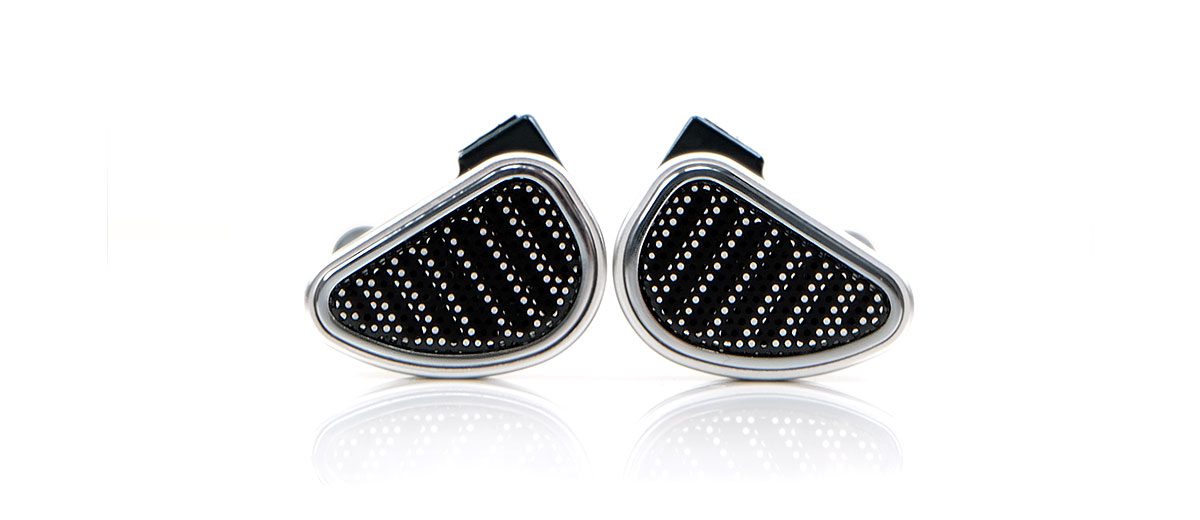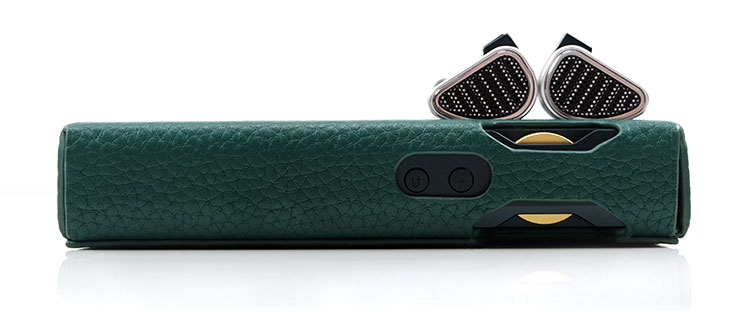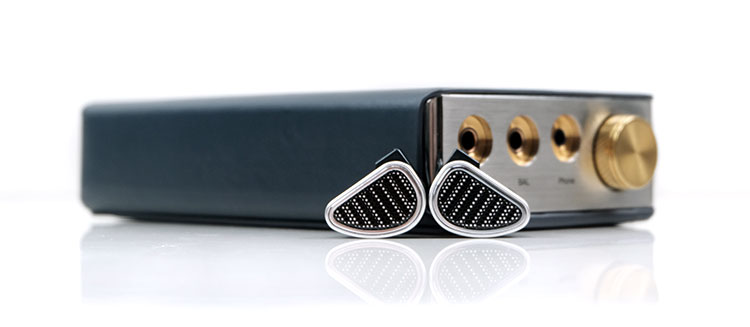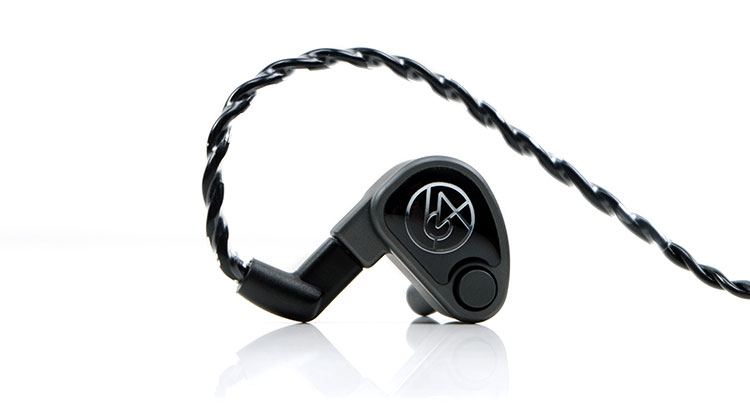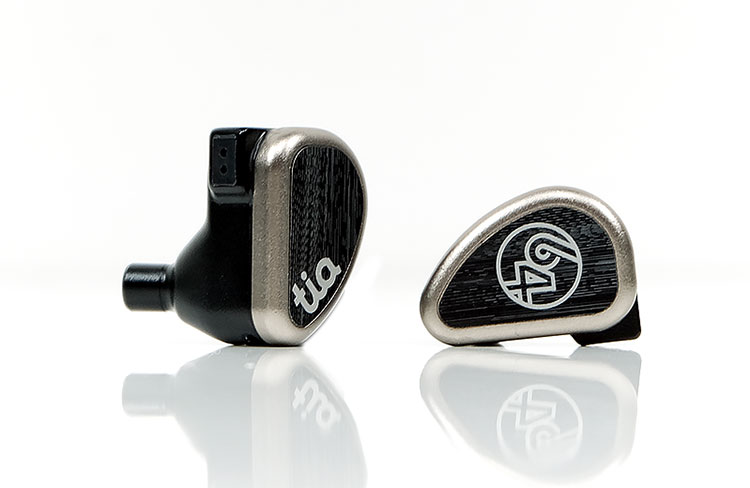Sound Impressions
Summary
Of course, the headline reads open back but the lasting impression is of a smooth, almost euphonic performance and perhaps a more relaxed version of the tia Trio. Not that I personally found the Trio to be as peaky as some might suggest, but rather the Duo is the more forgiving of the two hybrids with a very likable instrumental and vocal timbre.
The euphony does not come without power, and yes, the Duo 9mm dynamic driver, much like the Trio is tuned to reach hellish deep with some excellent sub-bass presence but also a little more mid-bass bloom and warmth which is a factor in its sweeter midrange sound.
I would say the character of the Duo bass sits somewhere in between the Nio and the Trio, not as thick as the Nio but not quite as tight as the Trio but still a dominant aspect of the tuning. One thing to note is the mids gain is a shade higher in the FR so you will find female and head voices, creamy and smooth as they are, come to the fore a lot more than sub-2k male or chest voices.
Treble does have shimmer but a very likable tuning with a controlled upper treble peak that I suspect benefits from that tia high open-back construction. It has some lovely extension but never feels aggressive or walled-in giving it more of an ethereal quality than a spicy hard-edged treble.
Tips are a factor. Foams will give you a fairly relaxed warm sound throughout and damp down on the treble shimmer more than the silicone options. The narrow silicone bores will give you a punchier bass tone but also enhance the treble adding a bit more contrast to the mids timbre.
Frequency Response
The Duo is a relatively V-shaped tuning and though I am not a huge fan of classic v-shaped monitors, this is one of the nicer versions out there with a very nuanced treble lift around 8k and a good 1-3k gain for higher pitching vocal prominence.
The low-end is at its strongest from 20Hz to 100Hz so both sub-bass and mid-bass have plenty of emphases creating what 64 Audio has described as having a pillowy character. I can’t really disagree with that as the word voluptuous came to my own mind.
It’s not as rich and heavy-handed as the Nio which does push the sub-bass even further but neither is it as tight and punchy as the larger Trio 10mm driver. The Trio has less of a mid-bass elevation but the Duo does stretch as deep and perhaps offer even more quantity than the higher-end model.
You will find some of that Duo bass tuning warmth travel into the lower mids, however, the Duo’s lowest point is around 800Hz to 1k to ensure it is not a muddy sound, which it isn’t.
From there, it rises and peaks at 3k which places higher pitching vocals to the fore but it still doesn’t convey quite the vibrancy and intimacy of something like the U6t or the Trio. I suspect this is more to do with dynamic versus multiple BA in terms of detail and articulation versus smoothness and body.
There is a dip from 3-4k that’s there to temper any sharp partial overtones from the treble tuning which is further damped down through using the foam tips. Otherwise, expect some nice airy shimmer from an elevated 8-10k range over a more subdued 5-7k lower treble tuning.
Timbre
Overall, the Duo timbre is warm to sweet-sounding, with a nice euphony through the mids and a shimmer in the treble that is airier and light in application than hard-edged and fatiguing.
In fact, that is how I would describe the majority of the Duo timbral qualities, as non-fatiguing with a smooth attack and equally smooth and long decay. However, it is achieved also without cutting off the treble extension and creating a dark sound, something which the heavier hitting Nio has been described as.
The bass fundamental is excellent with plenty of power and sub-bass reach but not an overly thick-sounding driving delivery. It has a naturally slower sounding decay with a rounded tone right at the base of notes with a degree of softness in the attack.
If there is one critique though is the resolution in that dynamic driver which, whilst great at creating a very natural and likable instrumental and vocal timbre, does not possess the same articulation or attention to detail as the Trio, U6t, or the Nio with their additional midrange BA drivers.
However, I think 64 Audio got the overall coloration just right on the Duo and perhaps extending that dynamic driver up into the mids as well as the lows is responsible for the relative coherency and natural overtone it creates. The Duo is a very easy sound quality to pair with as a result.
Staging
I am cautious about overstating the soundstage of the Duo as open in the same way as something like the Audeze LCDi4 which it is not. However, comparing them to the alternative closed monitors in the 64 Audio line-up you will hear a qualitative difference with the U6t sounding more intimate and the Nio sounding a bit darker and less airy up top.
I do actually think on a macro level the Duo casts the bigger soundstage compared to the Trio also but the Trio does a little bit better with imaging precision on a micro level with that additional level and tighter bass tuning. The sharper lower treble can also create a stronger perception of detail and focus in the upper mids compared to the Duo.
However, the way notes come and disperse into nothingness gives the Duo quite a different quality. Like an open-back headphone in a way, there is less of a wall to the staging, so it casts an almost grandiose sensation but never feels artificially wide.
Depth is also excellent but then I would expect that coming from the previous hybrid 64 Audio monitors which are all very good indeed at delivering power and gravitas to their respective sound signatures.
Synergy
Efficiency
The Duo is rated at 8Ω and a fairly inefficient 98dB SPL, probably the least sensitive 64 Audio IEM I have tested to date. It does require a fair bit more current to volume-match compared to the likes of the U6t, the Nio, and the tia Trio.
As an example, all three ran between 8-12 steps or around 4-6dB lower in SE low gain on the LPGT test DAP compared to the Duo depending on the loudness or dynamic range of the track being played.
I would advise pairing this with everyday 3.5mm jack smartphones or weaker powered dongles. Even the PAW S1 in SE required about 85-90 on high gain and about 75% volume matching on a tested Huawei P20 to get to the required volume levels to sound good. I would suggest switching to a balanced cable here if you want to use the stronger 4.4mm output of the PAW S1.
The flip side is the lack of noise being picked up by the Nio means stronger amplification will produce no background noise on all our tested DAPs. Reverting to 64 Audio’s Premium 8-braid cable with its balanced jack DAPs like the HiBy R8 ran quiet as a church mouse, even when in high gain turbo mode.
Pairings
Pairings will largely depend on what are of the Duo you wish to emphasize or tweak. From 7 DAPs tested I tend to lean to neutral clean ones that emphasized either the vocal and brilliance region or the open staging quality of the Duo.
For an open staging size and the maximum resolution, the iBasso DX300 MAX did the best out of the delta-sigma DAPs with some excellent headroom. However, I felt a little unmoved by the neutral midrange imaging so for those wanting a bit more coloration, sub-bass emphasis, and some vocal gravitas then the R2R R01 from Cayin or the flagship P6 Pro from LP are better fits.
I also wanted a DAP that would keep the bass relatively tight and not add too much bloom which ruled out the Lotoo PAW S1 which I felt was a bit spongy on the low-end performance. The Lotoo PAW Gold Touch is a much superior source for the Duo with a tighter and snappy low-end bass and very clear vocals.
The HiBy R8 and the DX300 AMP11 MKI are more for those who want to keep that romantic slightly soft and euphonic character of the Duo. The R8 will do that via a slightly weightier and warmer bass and the DX300 will push the vocals further up with an analog quality to the sound. I personally preferred the cleaner AMP12 performance with the Duo.
Select Comparisons
64 Audio U6t
$1299
The U6t was the most accessible monitor in 64 Audio’s current universal lineup before the Duo was launched. The U6t is an evolution of the A6t and the older A6/U6 whereas the Duo is something entirely new.
However, both share some common characteristics such as the use of tubeless tia highs and LID. Where they differ internally is their driver configuration, the implementation of apex, and the most striking difference, the open back grill and Wave Sync of the Duo.
Technical
Inside, the Duo uses but 2 drivers compared to the 6 inside the U6t but the driver mix and implementation are quite different. The U6t is an all-BA build with 2 for the lows, 2 for the mids, 1 mid-high, and a tubeless tia high driver for the highs and an integrated 4-way passive crossover.
The Duo is a hybrid mix of a 9mm dynamic driver for the lows and mids combined with a single tia high open balanced armature.
However, despite being nominally listed as using a simpler 2-way crossover, the deployment of Wave Sync phase control combined with the filterless apex core open back grill system and a single large tubeless tia bore makes the Duo a very different acoustical solution.
On paper, the U6t is listed at 10Ω and 108dB SPL compared to the Duo’ similar 9Ω impedance but vastly more efficient compared to its 98dB SPL rating. I would say that disparity is quite accurate with our real-world tests on the LPGT where the U6t required far less current than the Duo.
Design
Given there are fewer drivers in theDuo the dimensions or form factor is a little bit shallower compared to the U6t. However, it’s the engineering improvements and aesthetics that are the real talking points here.
I have to admit I think the Duo filterless visual is more intricate with improved finishing compared to the current U6t design. I do wonder if aspects such as the flush plate to shell construction will soon find their way into future U6t production runs.
You can tweak the U6t airflow giving it a bit more flexibility for performance and isolation compared to the Duo with 64 Audio’s apex filter module system of which 3 are included, mX, m15, and the highest dB attenuating m20.
However, this is still essentially a closed-back monitor versus an open-back monitor design. If you want superior isolation the U6t is the way to go, though, in terms of comfort, both offer a flush fit in the ear with the tips providing the ‘last mile’.
Both monitors use the new low-resistance 26AWG SPC 4-wire Premium cable so there shouldn’t be any performance concerns from different stock cable choices between the two.
Performance
The hybrid Duo versus all-BA U6t is a bit like macro versus micro or scale versus detail and I am pretty sure if you are A/B’ing these two you can easily discern which one is right for you.
The Duo excels on airiness, scale, and that dynamic driver’s natural timbre and power. The U6t is more intimate, narrower in staging also but delivers better detail and focus in the mids and slightly faster bass performances.
Now I have commented before that the U6t BA bass is excellent but it will pale in comparison to the depth and power of the Duo 9mm dynamic driver when you throw some bass-heavy stuff at both of them.
The U6t will deliver an atypical slower more natural type of texture for a BA monitor, however, the Duo will extend deeper, offering a stronger fundamental, better texture with a slightly rounded tone.
Mids are more forward on the U6t with a bit more clarity and focus on vocals. You get that cleaner BA edge to them that brings out a bit of sparkle and presence whereas the Duo has a more rounded smooth tone but not quite as clear and forward in terms of imaging. The Duo has that 3-4k dip that takes a little bit of air out of the upper mids performance also.
Definitely, more headroom and sparkle from the top-end of the Duo, particularly if you switch to the silicone tips. You can really pick up on the lack of staging restrictions that the narrow and more relaxed closed-shell U6t tends to convey. Also, the U6t FR is quite muted from 5-8k where the Duo is quite the opposite which translates more ethereal treble energy.
64 Audio Nio
We reviewed the Nio late last year and like the U6t, this could be considered a universal version and evolution of the custom N8 from the 64 Audio Stage Series.
$1699
Technical
Like the Duo, the Nio is also a hybrid monitor but the configuration is vastly different with the Nio a 9 driver and the Duo a dual driver. The Nio configuration is a single 9mm dynamic driver for the lows, 6 BA for the mids, 1 BA for the high-mids, and one tia BA for the highs.
The Duo also uses a 9mm dynamic driver but it extends beyond the lows to cover the mids right up to around 4-5k. Beyond that, it also has a single open tia high balanced armature with both blended using an integrated 2-way passive crossover as well as Wave Sync as opposed to the 4-way inside the Nio.
Both monitors use LID but their implementation of apex is quite different from the Duo which has that open-back grill and apex core fixed attenuation design and an entirely tubeless large tia bore nozzle. The Nio is more like the U6t with the classic apex interchangeable filter system within a closed monitor design.
On paper, the Nio is rated at just 6Ω @1kHz but has a moderate level of efficiency for SPL at 105dB. That is still a fair bit more sensitive to the Duo which is rated higher at 10Ω and just 98dB SPL. Much like the U6t comparison, the Nio required less current and a lower volume for optimal listening levels using our test LPGT DAP compared to the Duo.
Design
Along with the U18s, I think these two monitors exemplify the best of the two design visions 64 Audio has for their universal series of monitors.
On the one side, you have the striking blue abalone, chrome plating, and polished black shells of the Nio and on the other hand, you have that sleek, uninterrupted open back grill and chrome bezel finish of the Duo. Both are very attractive designs, equally comfortable in their own right but if you want better isolation then the Nio will offer it.
However, from a purely engineering perspective, the new Duo improvements such as the flush plate to shell fitting does look tighter and cleaner compared to the Nio’s slight plate to shell gap.
In terms of dimensions, given the Nio has a much larger driver count and the apex module system it is the deeper of the two monitors though their width is more or less the same.
One thing to note, and this is the same with the U6t, is the height of the cable connector stem. The Nio version is a fair bit taller compared to the Duo which has a very flat stem more in line with the tia Trio.
If I am not mistaken, the Nio now uses the new 26AWG 4-wire SPC low resistance cable that comes with the Duo and the U6t as opposed to the older 28AWG 4-wire SPC in our original review from last year.
Performance
The Nio is the comparatively darker and heavier hitting of the two monitors with a stronger sub-bass presence and body, more upper-mids energy but a more relaxed but clear treble presentation.
The Duo is breezier, more euphonic but also with excellent sub-bass slam, a midrange that’s geared more to female than male vocals, and more shimmer and air in the highs. Of the two, the Duo is the more open sounding but like the U6t comparison lacks a little bit of vibrancy in the upper mids.
The Duo extends just as well but with less sub-bass elevation so it sounds a shade lighter and not as omnipotent when the music demands a heavy low-end response. Of the two, the Nio creates the stronger fundamental but it also pulls your listening attention further down to the base of the notes whereas the Duo has a more centered harmonic balance.
The key difference in the mids is the sustained elevation on the Nio BA drivers from 2-5k whereas the Duo dynamic driver peaks a bit higher at 3k but drops some energy from 3-4k most likely to clamp down on any unwanted dissonance in the timbre.
Female vocals thus have a sweeter and fuller sounding consistency in texture or timbre on the Duo whereas the Nio is more detailed but thinner with more odd-harmonic energy. You will hear a little bit more contrast in the Nio vocals as a result.
Treble sounds airier with more shimmer on the Duo whereas the Nio is more relaxed, especially through the upper treble which is a little more damped down. I suspect the more open design of the Duo also helps to create that spacious airy feel also.
64 Audio tia Trio
$2299
Probably one of my most referenced monitors over the last few years and also part of the tia series of monitors though at a slightly higher price compared to the Duo.
Technical
Three driver hybrid meets two driver hybrid with the tia Trio the next monitor up from the Duo. However, you could argue that it is the Duo with the bleeding edge technology whereas the tia Trio represents the previous generation of the tia series.
Inside, the tia Trio uses a similar dynamic driver grouping for the lows and mids but it’s a slightly larger back-vented 10mm as opposed to the 9mm inside the Duo. The rest of the configuration is one high-mid and one tia high using an integrated 3-way passive crossover compared to a single tia high with a 2-way integrated passive crossover inside the Duo.
The other major differences include apex core and Wave Sync phase control inside the Duo using an open-back design compared to the closed shells and the fixed internal m15 apex filter of the Trio.
Both monitors use LID with low impedance ratings with the Trio rated at just 5.5Ω and 104dB SPL and the Duo a bit higher at 10Ω and a less efficient 98dB SPL. In our real-world tests using an LPGT DAP in SE mode, both are ways enough to drive but the tia Trio was the more sensitive of the two monitors for volume.
Design
Aside from the visuals, these two do have some similarities with the flush plate from the lack of interchangeable apex filters, short connector stem, and shallower body shell.
However, as with the U6t and Nio, the engineering is the previous generation with a wider gap between the more bulbous plate and the main body. The 3-piece design of the Duo looks tighter, smoother, and cleaner. As with the U6t, I do hope future Trio’s can adopt the new build methodology of the Duo.
In terms of dimensions, both have a shallow shell design that is almost identical in size though the slimmer plate does make the Duo feel the smaller of the two monitors. The fitting is these quite similar in the ear with the tip choices more or less the same also.
The one key difference is the dB attenuation for passive isolation which is fixed for both with the closed Trio doing better at -15dB compared to -12dB for the open-back Duo.
I am not sure if the tia Trio now comes with the 26AWG SPC 4-wire cable upgrade similar to the previously compared monitors and the Duo. The website pictures still show the older 28AWG SPC 4-wire which for me has slightly less dynamic range and is physically not as easy to manage.
Performance
The Duo kind of follows a similar path to the tia Trio with its extended power bass, shimmering highs, and excellent female vocal presence.
However, the timbre is not as similar and neither is the level of detail with the Trio chest-beating that additional BA driver in the mids that does tip the balance in its favor and rightly given its higher price.
You could argue though that the Duo is tuned exactly to target those who might have found the stronger treble of the Trio to be a bit on the spicier side and indeed the Duo does sound smoother, more liquid in tone on the top-end and broader and more euphonic with that dynamic driver timbre through the mids.
However, the additional detail and a stronger 1-3k gain from the Trio do tease out superior midrange complexity and vocal presence. It also counters the excellent dynamic driver bass slam and power quite nicely. The Duo just lacks a little emphasis there opting instead for a more forgiving tone and giving you a very listenable female vocal.
On the low-end, the Trio bass performance is a little tighter, not as voluptuous as the Duo which offers a bit more gain and amplitude through the mid and upper bass. You get plenty of power from both but some additional warmth and bloom from the Duo that does contribute to that smoother mids tone.
Staging is interesting when comparing both. I actually think the Duo paints a bigger macro staging quality but the Trio does better with the separation and imaging within its staging, creating a more complex and detailed soundstage.
Our Verdict
I normally expect to see bleeding edge technology at a flagship-level trickle down to the lower-end models but here we have an ‘entry-level’ model that is entirely different from anything else in the 64 Audio line-up.
If you are wondering ok, Duo or U6t for your money then the contrasting tonal signatures should make your choice a relatively easy one. The U6t with more intimate detail-orientated mids and a solid bass line, or the Duo with a grandiose smooth coloration, a voluptuous powerful dynamic driver timbre, and shimmering highs.
I am fascinated to see where 64 Audio will go with this new technology and improved build quality, be it upwards with more complex offerings that nail the detail or downwards into even more affordable options that would please an even wider audience. Either way, it’s a promising and immensely likable beginning.
64 Audio Duo Specifications
- Driver Type/Count 2 Drivers – One dynamic driver and one balanced armature driver
- Driver Configuration 1 tia high, 1 dynamic low
- Frequency Response 20Hz – 20kHz
- Sensitivity 98dB/mW (98dB @ 1kHz @ 1mW (95mV)
- Impedance 9Ω
- Crossover Integrated 2-way passive crossover
- Isolation -12dB internal apex technology

